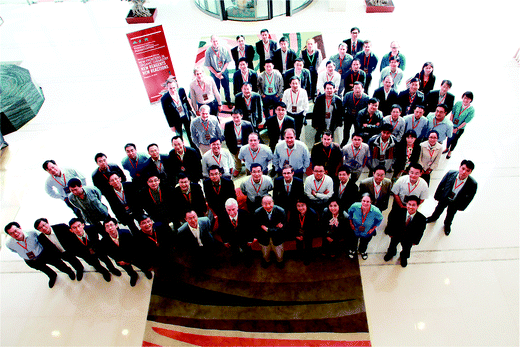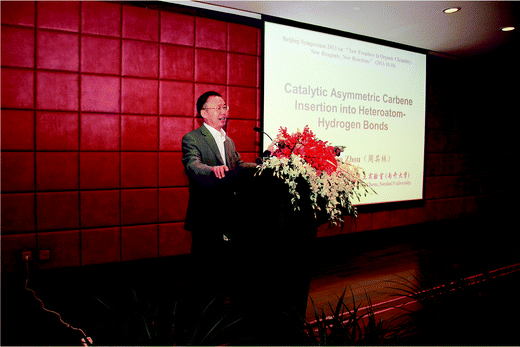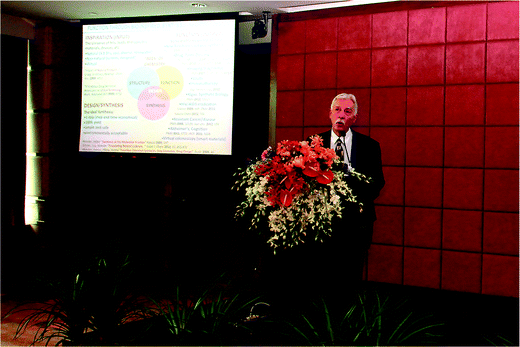Beijing symposium 2013: frontiers in organic chemistry
Qiang
Kang
*a and
Wenjun
Liu
*b
aState Key Laboratory of Structural Chemistry, Fujian Institute of Research on the Structure of Matter, Chinese Academy of Sciences, Fuzhou, Fujian 350002, China. E-mail: kangq@fjirsm.ac.cn
bThe Royal Society of Chemistry, Beijing Office, 2 Kexuyuan south road, Beijing 100190, China. E-mail: liuw@rsc.org
First published on 13th January 2014
In last two decades, China has witnessed rapid progress in fundamental research of all scientific disciplines. Chemistry is among those disciplines that have benefited from the steady increase in funding support and enjoys fast track development. In addition to the increasing number of publications of high quality, China also actively carries out international exchanges by individually inviting foreign speakers, participating in international conferences abroad and organizing international conferences. The Department of Chemical Science of the National Natural Science Foundation of China (NSFC) has been the main promoter for the fundamental research of Chinese chemistry. They not only support the Chinese chemists by funding research projects but also initiate the international exchanges and collaboration for Chinese scientists to promote chemistry in China, and at the same time contribute to the chemical community world wide. High standard international conferences, together with the exchanges between young Chinese scholars and world-leading elite chemists, are among the best formats for executing international exchanges and collaborations. For a long time, the Department of Chemical Science of the NSFC has been trying to put on a unique international conference to most effectively promote international collaboration, increase the global impact of Chinese chemistry, and advance chemical sciences internationally.The Department of Chemical Science of the NSFC started to explore such conferences three years ago. The international young scholar symposium on “Cleaner, Greener Chemical Processes” and the first international symposium on C–H activation were organized by Professor Zhang-Jie Shi in 2011 and 2012 respectively under the sponsorship of the NSFC. With the success of these two symposia, the Department of Chemical Science of the NSFC decided to take this a step further to initiate the Beijing Symposium as a brand name conference. This conference series is planned to be held every two years in China with one focused topic each time, featuring the most important area in chemistry. Designed for a limited size and attendance by invitation only, the Beijing Symposium brings the most active foreign scientists and Chinese young scholars together, in order to foster fruitful interaction between each other. It will provide an ideal platform for all of the participants staying together to discuss topics of mutual interest and to explore potential avenues for new collaborations among these international young chemists. In addition, this symposium invites several outstanding senior scientists and so the young scholars will benefit greatly from getting to know the leaders in their field at the early stage of their career.
The 1st edition of the meeting series is entitled the “Beijing Symposium 2013 on New Frontiers in Organic Chemistry: New Reagents, New Reactions”. It was co-organized by the State Key Laboratory of Natural and Biomimetic Drugs, Peking University (PKU) and the State Key Laboratory of Organometallic Chemistry, Shanghai Institute of Organic Chemistry (SIOC). Thanks for the generous sponsorship and endeavour from the two organizing parties, the Beijing symposium 2013 was successfully held on October 9–13 at the sequestered and beautiful Heyuan Royal Garden Hotel in the suburb of Beijing City. The Co-chairs Ning Jiao (the State Key Laboratory of Natural and Biomimetic Drugs, PKU) and Shuli You (the State Key Laboratory of Organometallic Chemistry, SIOC) undertook this challenging job of putting together the scientific program of the 2013 edition as well as an entertaining set of social activities.
This was certainly not easy, Ning and Shuli worked together with the other organizing committee members and finally collected a very impressive list of scientists who are highly active in developing new reagents and new reactions, including four plenary speakers: Paul Wender (Stanford Univ.); Erick Carreira (ETH); Qilin Zhou (Nankai Univ.); and Yadong Li (Tsinghua Univ.). There were 26 keynote speakers: Jérôme Waser (EPFL); Shannon S. Stahl (Univ. Wisconsin-Madison); Takashi Ooi (Nagoya Univ.); Bernd J. Plietker (Univ. Stuttgart); Valery V. Fokin (TSRI); Florian Monnier (ENSCM); Matthew S. Sigman (Univ. Utah); Kilian Muñiz (ICIQ); Shunsuke Chiba (NTU); Tom G. Driver (UIC); Sherry R. Chemler (SUNY, Buffalo); Tristan H. Lambert (Columbia Univ.); Dennis Hall (Univ. Alberta); Masahiro Terada (Tohoku Univ.); F. Dean Toste (UC Berkeley); Lukas J. Gooßen (TU Kaiserslautern); Song Ye (Inst Chem, CAS); Zhang-Jie Shi (Peking Univ.); Shuli You (SIOC); Liu-Zhu Gong (USTC); Ying-Chun Chen (Sichuan Univ.); Lei Liu (Tsinghua Univ.); Zhi-Xiang Yu (Peking Univ.); Ning Jiao (Peking Univ.); Jinbo Hu (SIOC); and Aiwen Lei (Wuhan Univ.). In addition, around 40 young Chinese professors were invited to contribute to the poster session (Fig. 1).
During the opening ceremony, a warm welcome was given by one of the co-chairs, Ning Jiao, and then followed opening remarks from Lihe Zhang (the founder for the State Key Laboratory of Natural and Biomimetic Drugs) and Yongjun Chen (the deputy director of the Department of Chemical Science of NSFC) respectively. In the remarks by Chen, the key promoter for this conference, he pointed out that the discoveries of new reagents and reactions have been and will remain the mainstream of organic chemistry. The NSFC hoped that the most important issues related with such a topic were discussed in order to advance the development of organic chemistry in general. Then the meeting started its scientific sessions including plenary lectures and other keynote speeches. Each presentation was followed by a 10 minute lively discussion (Fig. 2). The first plenary lecture was delivered by Qi-Lin Zhou who shared his research progress on the catalytic asymmetric carbene insertion into heteroatom-hydrogen bonds (Fig. 3). With the copper or iron complexes of the spiro-ligands invented by his group, the insertion reactions of carbenes derived from α-diazoesters into the N–H of anilines, O–H of phenols, water, and alcohols, and the S–H of mercaptans have been realized in excellent enantioselectivities with broad substrate scope. These significant advances proved to be remarkably promising for the construction of carbon–heteroatom bonds in the synthesis of natural products and pharmaceuticals. The rest of the presentations in the morning session were given by Jérôme Waser on the development of alkynylation methods using alkynyl hypervalent iodine reagents, by Zhang-Jie Shi on the metal catalyzed activation of inert C–O bonds, by Shannon S. Stahl on the development and mechanistic characterization of Cu/nitroxyl-catalyzed aerobic alcohol oxidation and scalable application of these methods, by Takashi Ooi on the catalytic activities and applications of quaternary onium salts into carbon–carbon and carbon–heteroatom bond formation, and by Song Ye on the exploration of the novel reactions by N-heterocyclic carbene catalysis.
In the afternoon session, Paul Wender impressed the delegates with an inspiring and informative talk on the development of reactions toward the ideal synthesis (Fig. 4). The emphasis of the presentation was placed on metal catalyzed [5+2] cycloadditions and their applications for the synthesis of new structures, medicinal leads, imaging agents and drug delivery materials. Prof. Wender demonstrated that organic chemistry has evolved from a relatively pure disciplinary pursuits to positions of central importance in a variety of disciplines, such as medicinal chemistry, biology and materials science. Nowadays, an increasingly important goal is to make molecules in a practical and green fashion with an emphasis on time and step economy and on the design or selection of high value targets that would produce transformative advances in science, especially for societal benefit. The afternoon session ended after another five excellent keynote talks.
After a buffet style barbecue dinner in the evening, an exciting poster session lasted till almost midnight that day (Fig. 5). The unlimited Tsing Tao beers during the poster session greatly smoothed the scientific discussions and deepened the idea exchanges between senior and junior research scientists.
 | ||
| Fig. 5 Poster and beer session on the night of 11 October. Professor Sherry R. Chemler from the State University of New York (left) and Professor Qian Zhang from Northeast Normal University (right). | ||
The morning session of second conference day was busy by incorporating six excellent lectures. Matt Sigman gave a deep insight into mechanism of migratory insertion and β-hydride elimination steps of the Heck reaction, based on which a one-step asymmetric synthesis of β-, γ-, or δ-aryl carbonyl products was realized from acyclic alkenol substrates by chiral pyridine oxazoline palladium complexes. Ying-Chun Chen spoke on the asymmetric synthesis of highly functionalized carbo- and heterocycles via aminocatalysis, while Kilian Muñiz reported the oxidative aminations catalyzed by hypervalent iodine reagents. The remarkable versatility of the Cu–O2 systems was highlighted by Shunsuke Chiba for promoting oxidative/oxygenative molecular transformation towards efficient construction of heterocycles. Zhi-Xiang Yu discussed Rh-catalyzed cycloaddition reactions of vinylcyclopropanes in synthesizing various ring compounds and their application in natural product synthesis.
The last lecture in the scientific session of day two came from Erick Carreira, who presented the discovery of novel Ir-complexes with a phosphoramidite–olefin ligand designed in his group. The new Ir-complexes have enabled various novel carbon–carbon and carbon-heteroatom bond forming transformations based on the Ir-catalyzed allylic substitution reactions. A notable work is the stereodivergent dual catalysis where the reaction was catalyzed by chiral iridium and amine catalysts. These two distinct and highly selective catalytic cycles merge very well and provide access to all possible stereoisomers of a desired target in excellent enantioselectivities.
The scientific topics were intensively discussed, not only during scientific sessions but also during the coffee breaks and the cultural and social events. The latter included a guided visit in the afternoon of day two to the Summer Palace—an Imperial Garden and world cultural heritage site—under bright sunshine and fresh air which were not often seen in Beijing, and the subsequent enjoyable banquet which was arranged at an extraordinarily and uniquely ancient site, with sponsorship from two local Chemical Companies, Innochem and Accela ChemBio Co., Ltd. All delegates were taken back to the “Qing Dynasty” during the banquet by enjoying the local cuisine and experiencing royal culture from that ancient time. The secret art of Sichuan “Bian Lian” (face-changing) opera and Chinese liquor (Bai Jiu), a rice wine with more than 50% alcohol concentration, were also served to the delegates at the banquet and were much appreciated.
On day three of the conference, 12 exceptional talks were scheduled with notable lectures from Jinbo Hu on the design of fluorinated reagents, from Masahiro Terada on the invention of chiral phosphoric acid catalysis, and from F. Dean Toste on the introduction of new concepts for asymmetric catalysis with cations and anions. In addition to the full day scientific program, a board meeting was held during the noon break. Paul Wender, Matthew S. Sigman, F. Dean Toste, Masahiro Terada, Qiyu Zheng (NSFC), Shuli You, Lei Liu, Ning Jiao, Jinbo Hu and Aiwen Lei participated in this meeting. They highly praised the exceptional talks, deep discussions and the good balance between the scientific program and the social activities offered by the Beijing Symposium 2013. All the speakers focused on the discussion on their latest discoveries on new reagents and reactions. Many of them showcased the application of these new reagents and reactions in the synthesis of functional molecules. There is no doubt that some of the discoveries will lead to the named reagents and reactions in the near future. More importantly, the committee members actively provided valuable comments and suggestions on the size, location and the next theme of the symposium, such as the opportunity of short talks for young scientists in their early career and more inspiring schedules for the meeting, which would be taken into consideration for the next symposium held two years later.
Bringing the symposium to a close with a touching address was co-chair Shuli You. He thanked all those responsible for this excellent conference and expressed his best wishes for the next edition of the Beijing Symposium in 2015 (Fig. 6).
The name “Beijing Symposium” will be inherited by the future conferences in the same series, although the venues and topics will be varied. Taking advantage of the rapid growth of the Chinese chemical community, the organizers do hope to establish the Beijing Symposium as a high-quality flagship meeting series in chemistry by gathering the best researchers, fostering fruitful collaborations between Chinese and foreign chemical communities and advancing the global development of the chemical sciences.
With the introduction of this conference report, the organizers hope that this Symposium will be the one that you will consider attending next time. We look forward to an exciting Beijing Symposium 2015!
| This journal is © The Royal Society of Chemistry 2014 |





